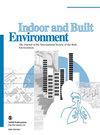Differences in heating effects of three personalized heating devices under various indoor temperatures: Table heating pad, cushion heating pad and leg heating pad
IF 2.9
3区 工程技术
Q2 CONSTRUCTION & BUILDING TECHNOLOGY
引用次数: 0
Abstract
The personalized environmental control system (PECS) meets the diverse comfort needs of occupants in an efficient way, amongst which, personalized heating systems have been extensively applied for heating in winter. Based on the differences in targeted body segments and application scenarios, the study of the heating performance and examining the applicability of different heating devices under various working conditions are necessary. In the present study, the heating effect of selected personalized heating devices including table heating pads, cushion heating pads and leg heating pads was investigated under different indoor temperatures (16°C, 18°C and 20°C). The results show that the cushion heating pads could produce the best heating effect in the environment at 16°C and 18°C. The average thermal comfort vote (TCV) was 0.00 and 1.08, respectively. While in the environment at 20°C, the leg heating pad (LH) was found to be the best with an average value of TCV to be 0.92. Personalized heating devices could directly enhance the thermal sensation and skin temperature of targeted body segments, such as the hands as well as legs, which are to be the most beneficial parts. The conclusions drawn above clarify the application scenarios of selected heating devices and will help to develop more energy-efficient heating schemes in winter.三种个性化加热设备在不同室内温度下的加热效果差异:桌面加热垫、坐垫加热垫和腿部加热垫
个性化环境控制系统(PECS)能有效满足居住者的各种舒适需求,其中个性化供暖系统已被广泛应用于冬季供暖。基于目标人群和应用场景的差异,有必要研究不同供暖设备在不同工况下的供暖性能和适用性。在本研究中,研究了选定的个性化加热设备(包括桌面加热垫、坐垫加热垫和腿部加热垫)在不同室内温度(16°C、18°C 和 20°C)下的加热效果。结果表明,在 16°C 和 18°C 的环境中,坐垫加热垫的加热效果最好。平均热舒适度(TCV)分别为 0.00 和 1.08。而在 20°C 的环境中,腿部加热垫(LH)的热舒适度最好,平均值为 0.92。个性化加热设备可以直接提高目标身体部位的热感和皮肤温度,例如手部和腿部,这是最有益的部位。上述结论明确了所选加热设备的应用场景,将有助于开发更节能的冬季加热方案。
本文章由计算机程序翻译,如有差异,请以英文原文为准。
求助全文
约1分钟内获得全文
求助全文
来源期刊

Indoor and Built Environment
环境科学-工程:环境
CiteScore
6.40
自引率
25.00%
发文量
130
审稿时长
2.6 months
期刊介绍:
Indoor and Built Environment publishes reports on any topic pertaining to the quality of the indoor and built environment, and how these might effect the health, performance, efficiency and comfort of persons living or working there. Topics range from urban infrastructure, design of buildings, and materials used to laboratory studies including building airflow simulations and health effects. This journal is a member of the Committee on Publication Ethics (COPE).
 求助内容:
求助内容: 应助结果提醒方式:
应助结果提醒方式:


